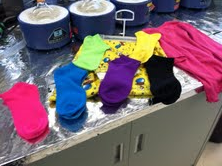Regular readers of this blog are already outraged that chemical companies can dream up new chemicals and market them to Americans without first making sure that they are safe. What’s even more disturbing is that our current laws can’t even get rid of chemicals that we know are toxic, even long after they have been “banned.”
That’s the case with PCBs, or polychlorinated biphenyls. These notorious toxic compounds have been banned under our federal law on chemicals — the Toxic Substances Control Act (TSCA) — since the 1970s. But a little known fact is that TSCA has a big loophole: PCBs are allowed in consumer products as long as their production is unintentional. Oftentimes, PCBs are by-products of chemical processes.
One process that generates a lot of PCBs is the production of pigments, which are used in paints and printing inks. Researchers at the University of Iowa tested batches of paint pigments and found a wide range of PCBs in them. My students here at Rutgers, the State University of New Jersey, have been testing consumer products that have printing inks in them, including newspapers, magazines, napkins, plastic bags, and even clothing, and finding PCBs in them. That’s right, there are PCBs in your children’s clothing, food packaging, and napkins!

The TSCA rules say that if PCBs are present in a product inadvertently, then the product has to be tested, the PCB levels have to be less than 50 ppm (parts per million) at all times, and the average concentration can’t be greater than 25 ppm. The European Union has similar regulations. The problem is that the manufacturers don’t have to report the results of the tests, and in many cases it is not clear that the tests are even being performed. Clearly the current system is not working.
Like everything else these days, the market for pigments is global. If you look at the Toxics Release Inventory, you find that the number of facilities making these pigments in the U.S. has dwindled from 14 in 1988 to only one in 2011.
The production has moved overseas, mostly to China and India. This makes it harder to enforce the regulations, even though the U.S. EPA applies exactly the same limits and requirements to imported substances as to things produced in the U.S. The government of Japan recently tested several batches of pigments and found concentrations of PCBs up to 2,000 ppm, or 40 times higher than the legal limit.
Although the limit set by TSCA is 50 ppm, the federal water quality standard for PCBs is just 64 ppq (parts per quadrillion!), which is about 1,000,000,000 times lower that the TSCA standard. This highlights yet another big problem with how we regulate chemicals in this country: the conflict between TSCA and other laws such as the Clean Water Act, which covers the water quality standards.
The Clean Water Act says that water quality standards have to protect human health and the environment. The TSCA standards also have to consider economic impact, but where they got a number of 50 ppm is something of a mystery.
Think about this from the point of view of a recycled paper mill. The ink in the paper they want to recycle can have up to 1,000,000,000 times higher PCB levels than the concentrations the Clean Water Act allows them to emit to our rivers and streams.
How can they possibly comply? Some recycled paper mills may be forced to go out of business if they can’t meet their effluent standards. That means we lose jobs here in the U.S. because of pigments produced overseas. Why not just eliminate the pollution at the source by using only pigments that don’t contain PCBs?
Right now, EPA has put out an Advance Notice of Public Rule Making regarding the use authorizations for PCBs. The Environmental Council of States has issued a resolution saying that EPA should work with industries to find safer alternatives to the PCB-laden pigments. At the very least, EPA should enforce the rules on the books and make sure that importers test all of their pigments and report the results before these pigments can come into the country!
At the end of the day there is no simple solution to addressing PCBs, but a good place to start is to reform the out-of-date TSCA. You can make a difference and take action today.




